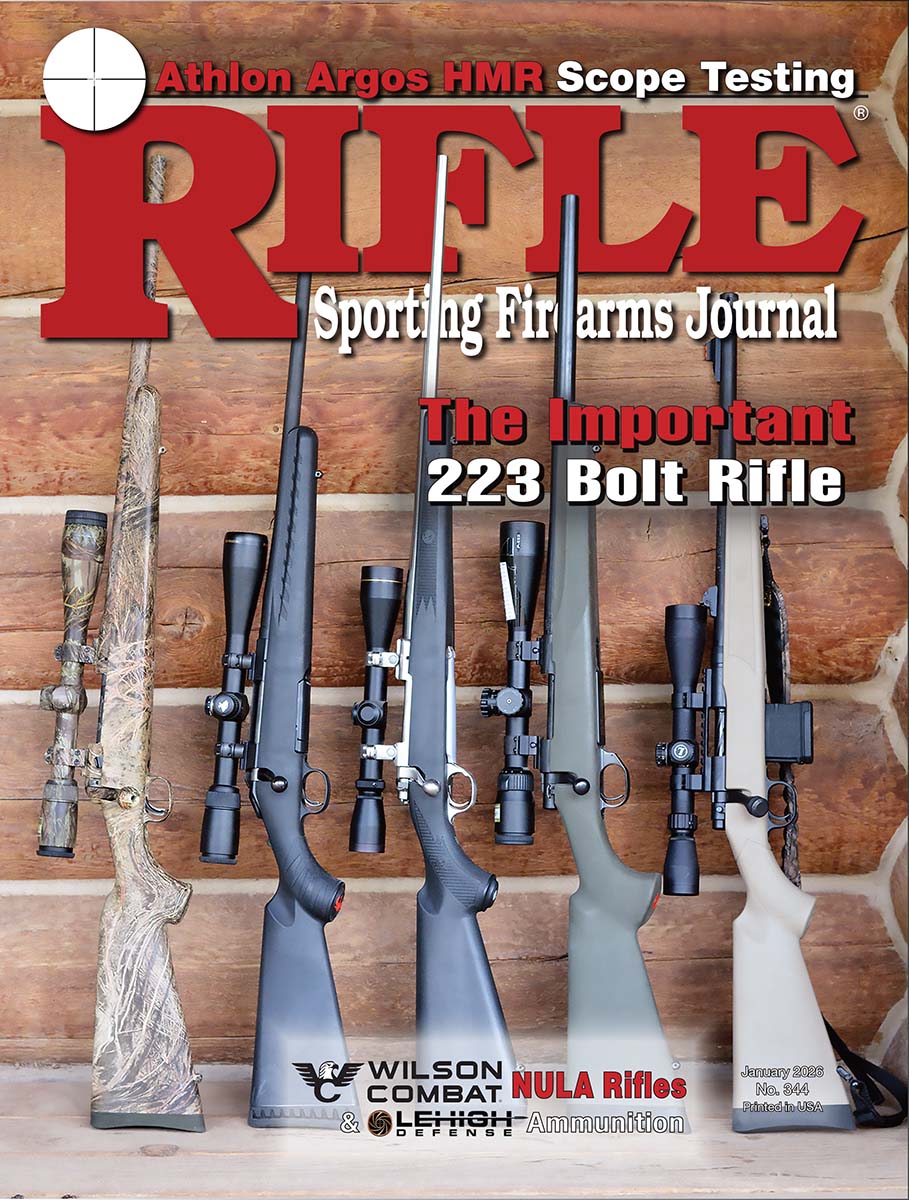
The Mossberg Patriot Walnut is a highly practical and handsome rifle that would fill most whitetail hunters’ needs, especially when chambered in the 350 Legend cartridge tested.
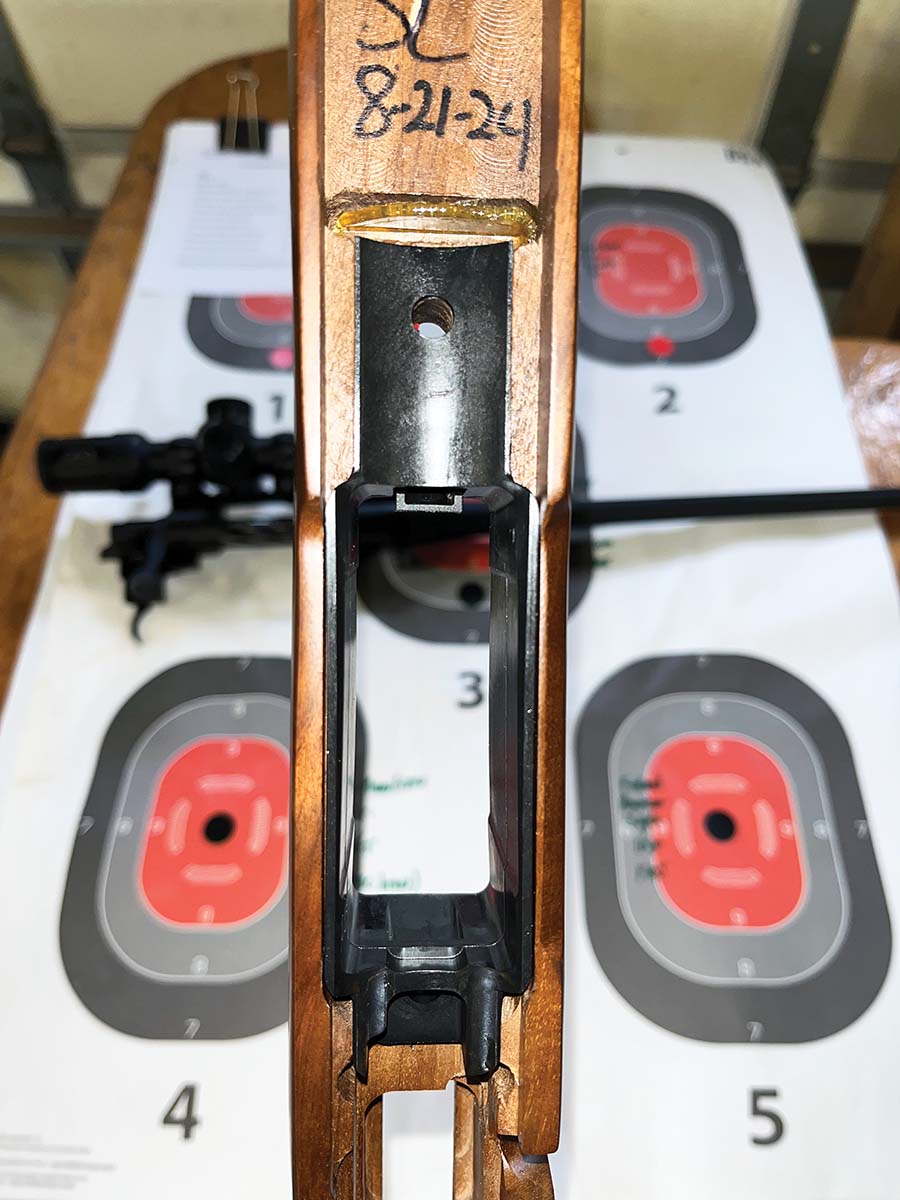
The recoil lug fit into a milled slot forward of the front anchoring bolt. This area was given a dab of bedding compound to tighten the fit. The polymer magazine well is adhered into the stock and includes thicker material fore and aft.
If you’d asked for an opinion on Mossberg bolt-action rifles just a decade ago, I likely would have given a dismissive shrug. I generally live by the motto that you get what you pay for, while also admitting to a touch of snobbery when it comes to rifle aesthetics and, most especially, accuracy. My first Mossberg rifle experience occurred because I was working on my book, The Predator and Varmint Hunter’s Guidebook, and wanted a selection of rifles with very distinctive aesthetics to use for interior illustration. That first Mossberg was an MVP Varmint in 204 Ruger with an ergonomic laminated-wood stock (no longer in production). It shot so well – sub-1⁄4-MOA well – that I purchased it and shoot it to this day.
On another occasion, I chose a synthetic-stocked Patriot Predator to tote on a Kansas whitetail hunt hosted by Mossberg and Swarovski, selecting the 243 Winchester chambering for sentimental reasons reaching back to my very first big-game animals. Seeking an accurate whitetail load and needing a LoadData.com subject to fill my monthly column obligations, I conducted a full load workup with updated bullets and powders. Again, I discovered an affordable rifle capable of impressive accuracy – not just big-game sufficient, but honest sub-1⁄2-MOA accuracy with select loads.
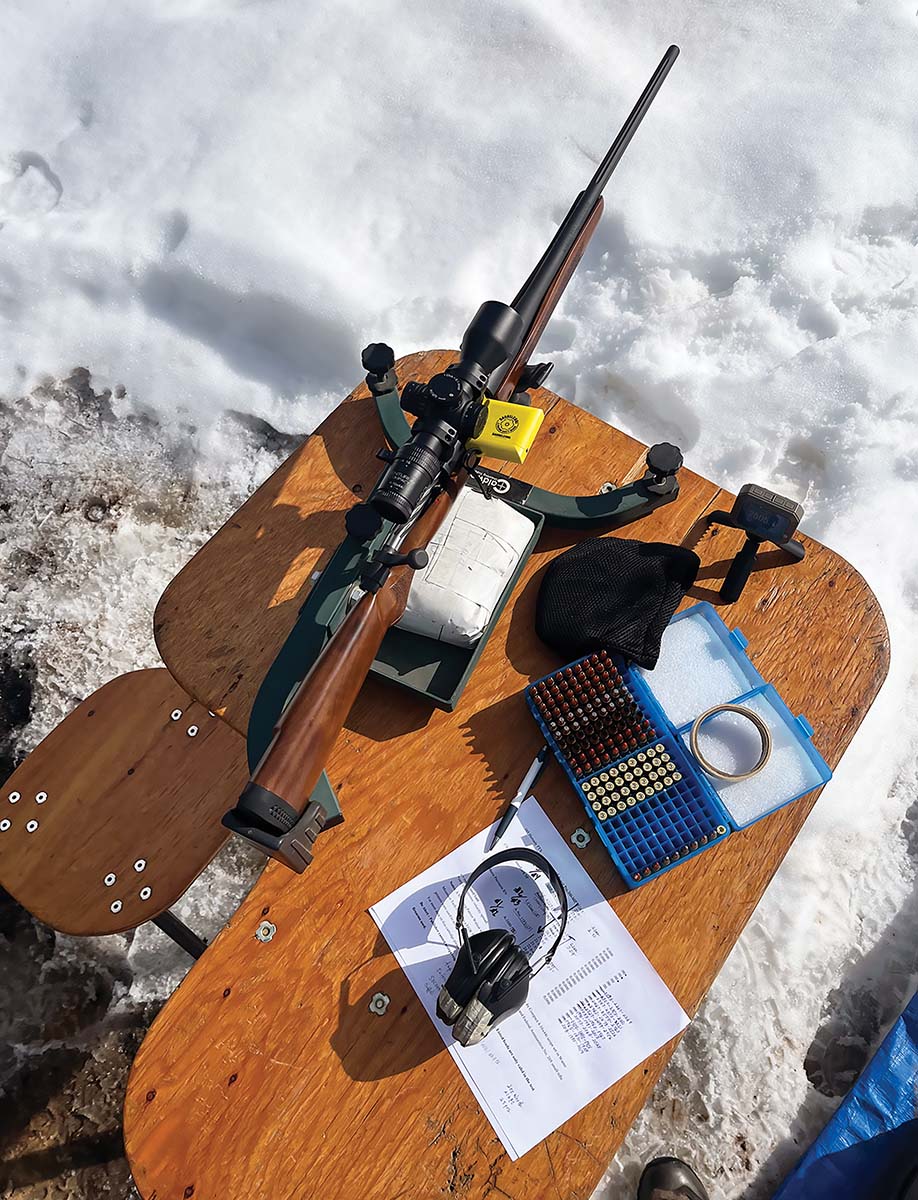
All shooting was conducted on a sturdy home-built portable bench. All velocities were recorded using a Garmin Xero C1 Pro chronograph.
I have shot a couple of other Mossberg rifles since then: a Patriot LR Hunter in 300 Winchester Magnum and, more recently, a
Patriot LR Tactical in 6.5 PRC. Both followed the same pattern: great accuracy at affordable prices. One of Mossberg’s most recent releases is the
Patriot Walnut, a handsome classic-looking
rifle with a surprisingly beautiful walnut stock, a 22-inch fluted barrel, Mossberg’s LBA adjustable trigger, a flush-fit four-round magazine and a pleasant seven-pound out-of-the-box weight. Like all Mossberg rifles, it is manufactured in the company’s Texas facility. Like other Patriot-series rifles, this elegant rifle is affordably priced (MSRP around $669, with a retail price likely $50–$75 lower).This Mossberg is chambered in the straight-walled 350 Legend, which garnered SAAMI approval in 2019.

The Mossberg Patriot Walnut has been taken down to its major parts. Several cost-saving measures were included in its design, but the final product is solid and reliable.
That makes it attractive for AR-15-averse hunters operating in straight-wall seasons such as those in Michigan, Pennsylvania, Indiana, Iowa, Ohio and other Midwest states. The 350 Legend could easily be mistaken for a 223 Remington case blown out to produce straight walls, but there are enough subtle differences in the case head that this is not entirely accurate. It includes the same .378-inch rebated rim; the case is 1.710 inches long (trim-to length 1.700 inches), with a .390-inch base tapering to a .378-inch neck. Overall loaded length is generally between 2.245 and 2.255 inches.
The Legend moniker has been mocked by some as a bit assuming, but the cartridge is a truly capable big-game round that fills its intended purpose as a Midwestern whitetail killer. I would also add wild hogs to that assessment, as it delivers the same thump at common sub-150-yard ranges as the 35
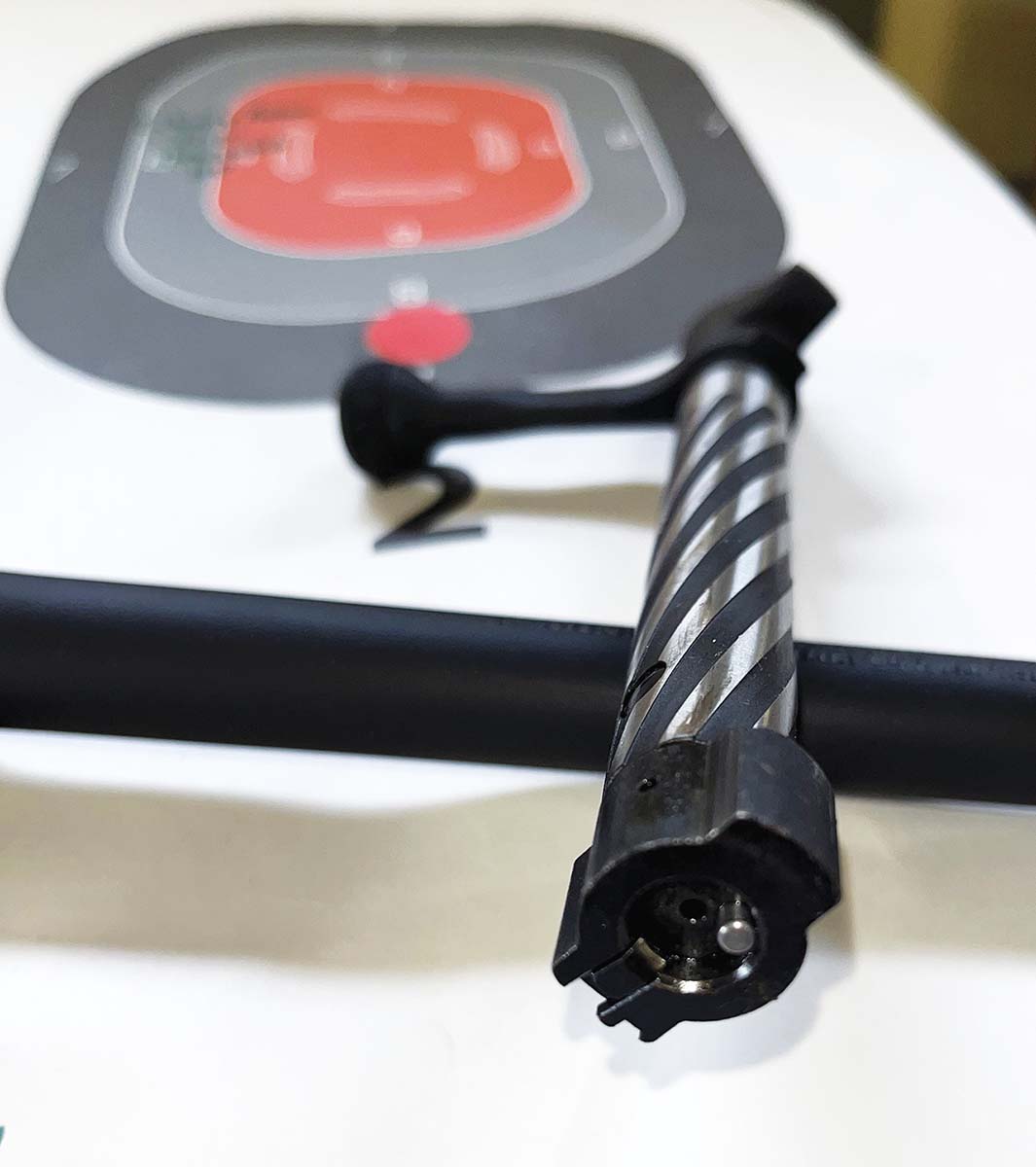
The hardened bolt head holds a small claw extractor on the right-side lug and a plunger ejector at the 5 O’Clock position. Ejection was positive and reliable.
Remington or the ancient 30-30 Winchester. There are now more powerful straight-walled cartridges to choose from, and many older classics remain available, but the 350 Legend proves amply powerful for white-tailed deer while producing very manageable recoil (about 10.05 foot-pounds of free recoil energy). It also produces considerably less muzzle blast than even the 223 Remington. Ammunition is reasonably priced and now available from
Winchester,
Browning,
Federal,
Hornady and likely others.
Winchester released the cartridge in a bolt-action rifle, but the AR crowd quickly adopted the round, which means factory ammunition is loaded to the same 55,000 pounds per square inch (psi) maximum chamber pressure as the 223 Remington. The 350 Legend fires .355-inch (9mm) bullets, not the .357-caliber slugs

The rifle has the company’s LBA Trigger, which includes a center blade design and can be adjusted down to 2 pounds. From the box, the rifle’s trigger broke at 3.38 pounds.
used by the 357 Magnum or the .358-caliber bullets fired by the 360 Buckhammer. In the very beginning, handloaders were forced to choose sturdier 9mm pistol bullets, but the cartridge has gained enough momentum that bullet manufacturers are filling the gaps with properly dimensioned rifle bullets weighing from 125 to 220 grains. Like other straight-walled cartridges, the 350 Legend is fueled by fast-burning “Hornet”/magnum handgun powders. Starline and Hornady offer excellent 350 Legend brass; I used Hornady for this round of testing because I had 150 brand-new cases on hand. Since my first 350 Legend project, load data has certainly become more abundant.
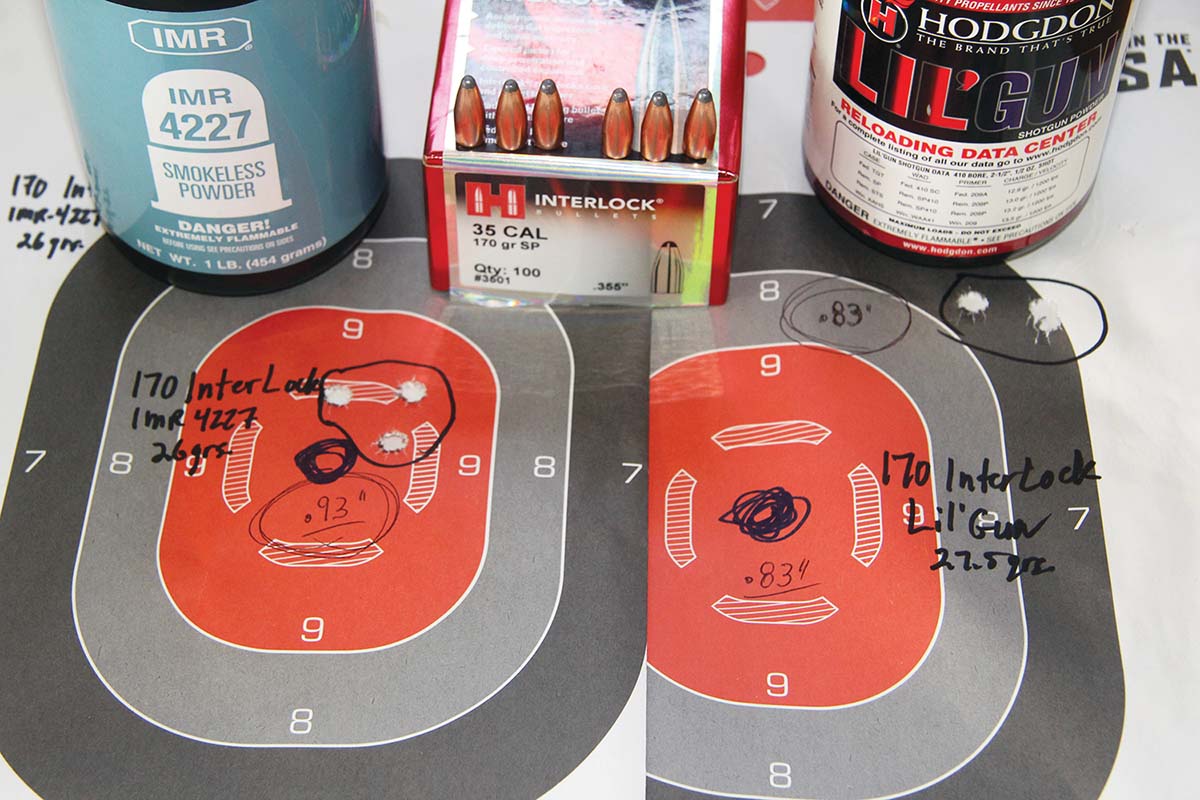
The smallest group of the test (right) included Hornady’s 170-grain InterLock and 27.5 grains of Hodgdon Lil’Gun – printing into .83-inch at 2,510 fps. Twenty-six grains of IMR-4227 (left) produced another sub-1-MOA group at just 2,263 feet per second (fps).
Handloading the round is a little more involved than the average bottleneck cartridge, because the process involves case sizing, mouth belling to prevent crumpled cases, bullet seating, and then crimping. The 350 Legend headspaces off the case mouth like automatic pistol rounds, so it requires a taper crimp. That prevents bullet creep under recoil and ensures consistent powder ignition. I have found a hard chamfer sufficient in place of the extra step of bell-casing mouths when loading bullets with boat-tails (mostly milled-copper bullets) or those with rounded base edges, but this requires starting the bullets gingerly. The 350 Legend’s best accuracy is realized by trimming cases evenly and applying that taper crimp. Crimping is conducted as a separate final step using the fourth die in Hornady’s four-piece Hornady Custom Grade die set, which was used to assemble all test loads.
The Mossberg Patriot Walnut, as hinted, is an aesthetically pleasing and tasteful rifle. It has the classic look of a matte-blued action and barrel bedded in well-figured walnut. The walnut stock included an impressive amount of figure for such an affordable rifle, enough to temporarily quell my aversion to wood stocks (I once viewed synthetic stocks as an abomination; more recently, I adopted a Black & Decker attitude toward rifle accuracy). The Patriot Walnut includes a generous raised cheekpiece and an effective vented rubber recoil pad. The two-panel grip and three-panel forearm checkering are pressed in, but are pleasing enough that I found them difficult to criticize. A Mossberg-logoed synthetic grip cap and front and rear sling studs were added. The entire forearm has been hollowed to shave weight, and the barrel is thoroughly freefloated.

The Mossberg Patriot Walnut is an affordable rifle, but nonetheless a solid and worthwhile hunting tool. It also includes an eye-appealing walnut stock with good ergonomics.
The action is held in the stock by two hex-head bolts, each base given a dab of red thread-lock. A third hex-head screw secures the rear of the molded-aluminum trigger guard. The action holds an ample recoil lug sandwiched between the receiver and barrel. This fits into a slot milled into the walnut in front of the forward anchoring bolt, which is given a dab –just a dab – of bedding compound to tighten the fit. The polymer magazine well is adhered into the stock and includes thicker material fore and aft, through which the action-anchoring bolts run. A steel cross-bolt runs through the side of the stock just behind the recoil lug slot, as on older Winchester Model 70 rifles. The forward action bolt hole includes a steel pillar in the bottom portion only.
These are undoubtedly cost-saving measures, but they appear to be adequately secure. That said, I did discover after disassembling the rifle to inspect the innards that over-tightening the middle action bolt prevents the bolt from working freely, meaning that the bolt cannot be truly snugged tight. Thus, the thread-lock concerned me because a certain torque setting is likely needed for best accuracy. Or maybe just avoid taking the rifle apart altogether.

The best factory-ammunition group was created by Hornady’s American Whitetail 170-grain SP loads. That group measured 1.02 inches center to center and was sent at 2,259 fps.
The carbon-steel, sporter-weight barrel is 22 inches long, fluted and includes a 1:16-inch twist rate in the 350 Legend and a recessed crown. All the way around, this seems an optimal compromise. This is a hunting rifle chambered in a straight-walled cartridge after all, so there is no need to go too long or too heavy. I cannot say that the barrel fluting accomplishes anything beyond looking snazzy, though it might help the barrel cool a touch faster in a light breeze. The rifle includes a 42.75-inch muzzle-to-butt length, making it decently lively and well-balanced between the hands. Like most Mossberg rifles, it includes a 13.75-inch length of pull suited to the masses. The Patriot Walnut hits the scales at 7 pounds as delivered, and 8.38 pounds with the addition of a
GPO Centauri Compact 4–16x44i Mil scope (9.9 inches long, 20 ounces) set in medium
Warne Mountain Tech rings on an
EGW Picatinny rail. The rifle arrived from the factory with two-piece Weaver-style steel bases, with anchoring screws thoughtfully thread-locked. Those were replaced by the Picatinny rail to accommodate the ultra-compact Centauri 4–16x’s conspicuously limited mounting latitude.
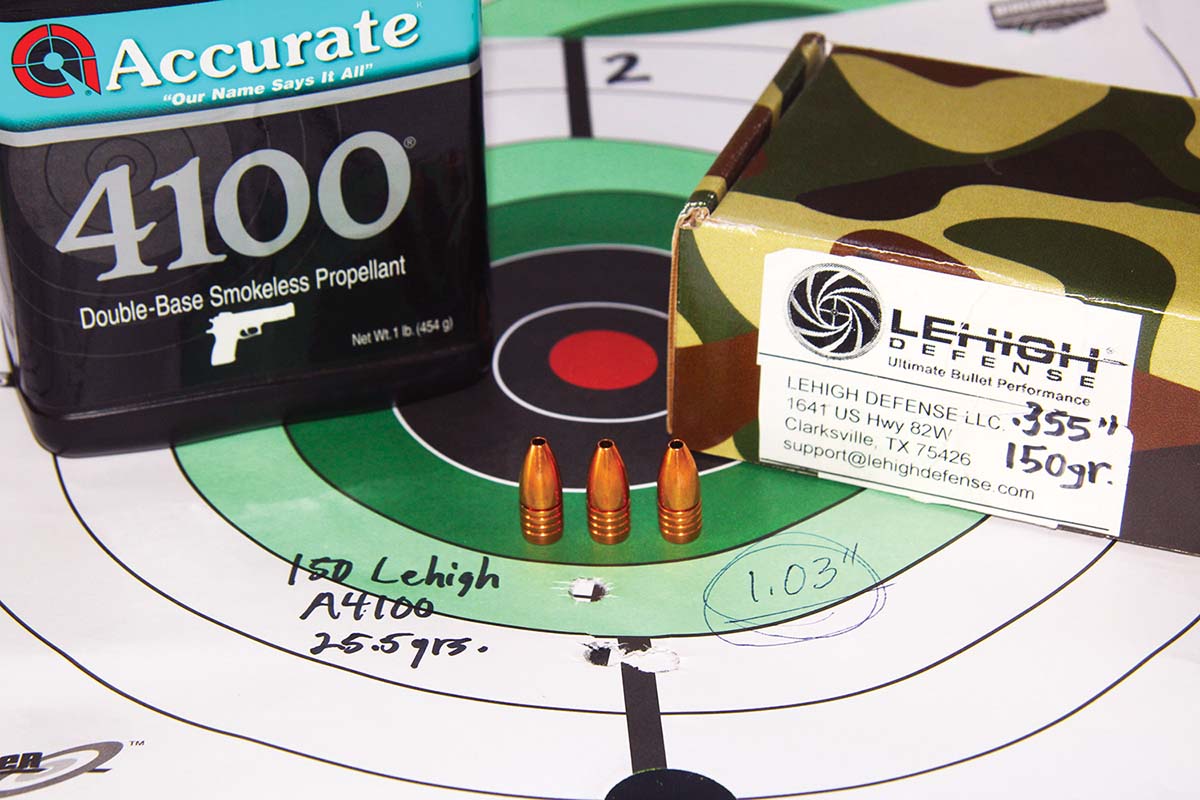
Lehigh Defense’s all-copper 150-grain Controlled Chaos and 25.5 grains of Accurate 4100 produced this 1.03-inch group, with a muzzle velocity of 2,516 fps.
The bolt is Mossberg’s standard Patriot two-lug, push-feed design. The hardened bolt head is pinned in place and holds a small claw extractor on the right-side lug and a plunger ejector at the 5 O’Clock position. Ejection was positive and unfaltering. The bolt body sports handsome spiral fluting, and the generous bolt handle includes a ring of light knurling. The bolt is easily removed for cleaning by pressing a left-side knurled tab against the stock; it is returned without pushing this tab. The safety is a simple two-position design arranged in Remington 700 style. When the safety catch is pushed forward to fire, a red dot on the stock edge is exposed. Pulling the safety back to prevent firing does not lock the bolt, which would become an issue only if you are in the habit of burrowing into thick, grabbing brush.
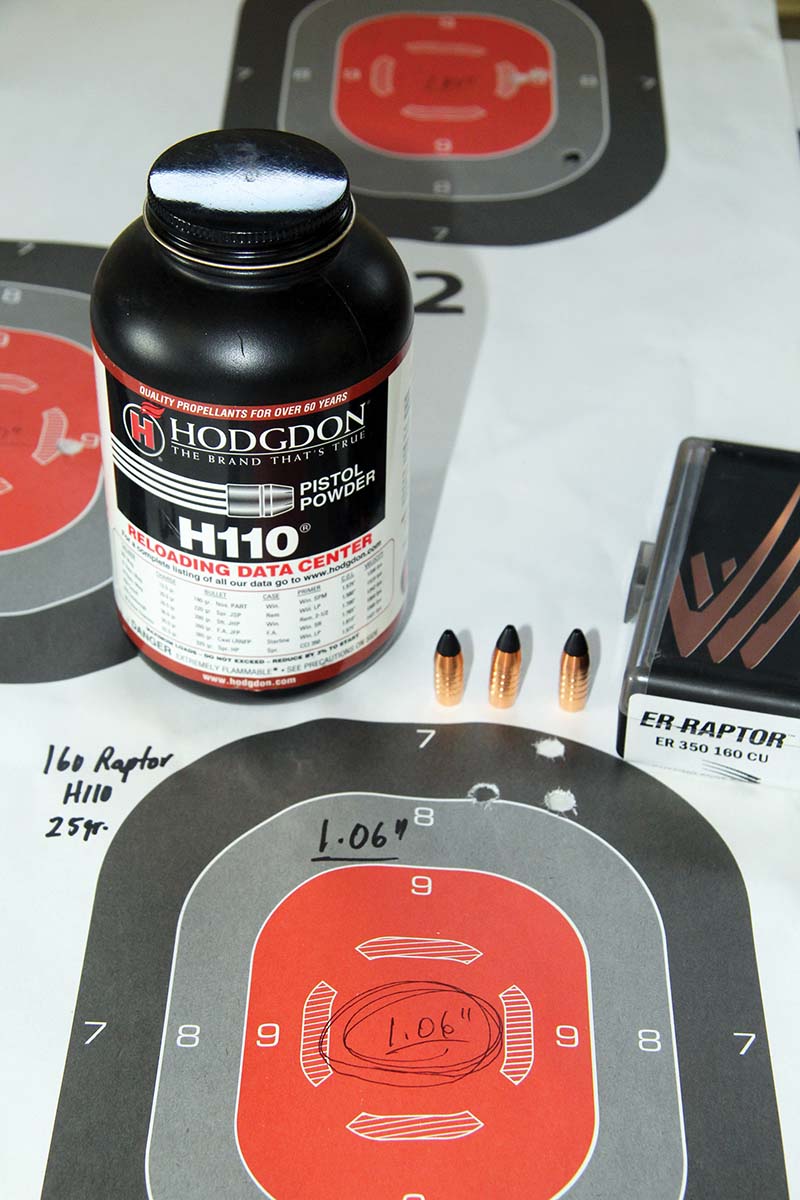
Cutting Edge Bullets’ nontoxic 160-grain ER Raptor produced a 1.06-inch group at 2,516 fps when combined with 25 grains of Hodgdon 110.
The rifle fed from a four-round box magazine that sat flush to the stock. Apparently, Mossberg is also developing a single-feed system to satisfy Illinois law. This Mossberg-logoed polymer design is easy to load and fed smoothly throughout testing with everything from pointed to flat-nose to round-nose bullets. Feeding was so smooth that, in fact, I found myself checking to see if a round had actually been picked up during cycling on several occasions. The box magazine was easy to insert into the polymer well and popped out effortlessly via a spring-loaded polymer tab located in a recess in front of the magazine. The design ensures no accidental dislodging and magazine loss in the field. The magazine did not produce any annoying rattling, even when unloaded.
One of the things I quickly learned to love about my MVP Varmint 204 Ruger is the Mossberg LBA trigger.
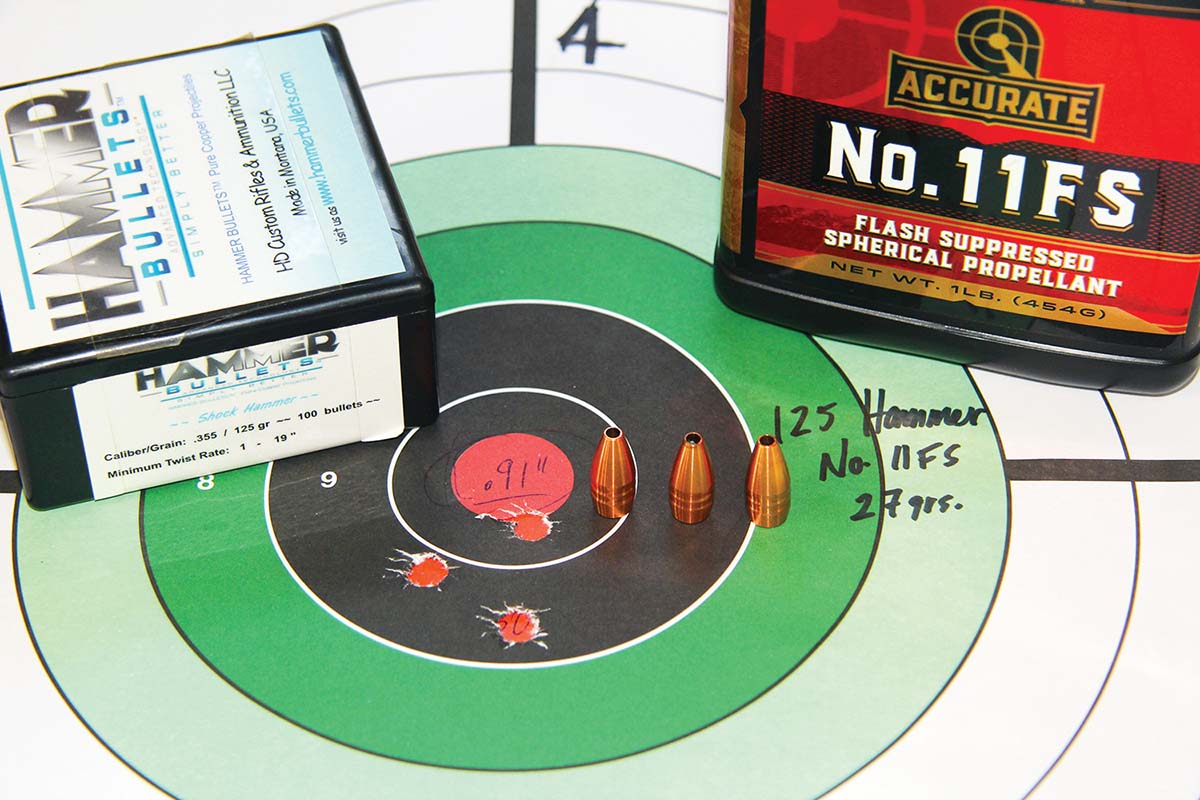
Hammer Bullets’ 125-grain mono-copper Shock Hammer and 27 grains of Accurate No. 11 FS produced one of the tightest groups of the test, printing into less than 1-MOA and clocking a zippy 2,667 fps.
The LBA is a now-familiar center-blade design – à la Savage’s Accu-Trigger – that allows dialing trigger pull down to 2 pounds or as heavy as 7 pounds if you are not really into accuracy. As delivered, the trigger broke at 3.38 pounds with the smallest degree of creep and internal spring ping up front, a crisp break and a solid stop. I would be curious to see if some of that up-front business would smooth out with more use.
The Patriot Walnut chambered in 350 Legend will not set any benchrest records, but it is certainly hunt-ready. I conducted a thorough load test for LoadData.com using this very rifle, running seven different hunting bullets weighing from 125 to 200 grains and about 10 different powders ranging from Ramshot Enforcer on the fast end to Accurate 1680 on the slow. That testing provided good insight into what this rifle is capable of doing. As will occur in handloading, a few loads printed into 2¼ to 23⁄8 inches, but the vast majority of loads assembled groups measuring between 1¼ and 1½ inches, which is all the accuracy a deer or hog hunter would ever need. You will find the cherry-picked loads in the accompanying table.
If I were in need of a 350 Legend, I would not hesitate to purchase this affordable rifle. Though being the obsessive-compulsive tinkerer and good-enough-is-never-good-enough type that I am, I would likely pillar and thoroughly glass-bed the action in the interests of long-term consistency. As it sits, any Midwestern stand-bound or still-hunting whitetail hunter looking for an affordable but reliable deer rifle chambered in a rock-solid and readily available straight-walled cartridge could not go wrong with Mossberg’s most recent addition to the growing Patriot stable. As a decided plus, you would also get a rifle that is easy on the eyes.












.jpg)


